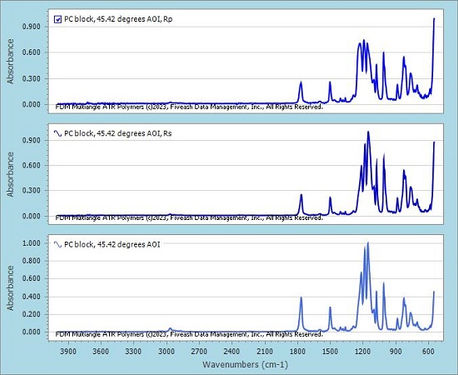
Phone: (608) 236-9145 Email: sales@fdmspectra.com
FDM Multiangle ATR Polymers
550 cm-1 to 4000 cm-1, single bounce ZnSe ATR crystal
4 cm-1 resolution
38.8 to 58.8 degrees angle of incidence (AOI), small increments
multiangle non-polarized spectra
multiangle Rp, Rs polarized spectra
The FDM Multiangle ATR Polymers is a unique spectral library providing a new perspective on polymer ATR/FTIR spectra. It is well known that ATR/FTIR peak positions, shapes and intensities can change as a function of AOI, especially for the strongest peaks at lower angles. But until now there have not been any libraries to browse or search spectra recorded on variable angle ATR/FTIR accessories or spectra recorded on ATR/FTIR accessories with other AOIs such as 60 degrees.
Multiangle or Variable Angle ATR spectra have an easy to understand advantage. Anything done with a fixed angle spectrum can probably be done better with a collection of multiangle spectra because there is more information and signal.
The library contains three types of ATR spectra: (1) not polarized and (2) Rp (p-polarized) and (3) Rs (s-polarized). The polarized spectra make it even easier to see pronounced features with varying AOI. It contains spectra of resin blocks, adhesives, sealants, gels, and a few simple paints.
Users can see what spectra look like at 45 degrees AOI and at higher and lower angles. At lower angles, many peaks are scanned above and below their respective critical angles showing users distinctive new features for searching or quantitation. Users can see how they can revise their ATR methods to easily attain substantial increases in sensitivity or simply additional distinctive spectra. At higher angles, spectra run on the ZnSe crystal resemble those run on a Germanium crystal, which are more transmission-like.
Scientists using Variable Angle ATR accessories for thin film analysis and depth profiling now have reference spectra to match their spectra over a wide range of angles (38.8 to 58.8 degrees). See the chemical name index. With the combination of the library, highly sensitive search algorithms, and the varying AOI, you can identify the spectra of many materials over a wide range of AOI and polarizations.
Scientists with a conventional fixed angle ATR accessory and no polarizer working with partially or completely polarizing samples can compare them with the polarized spectra in this library.
Rp and Rs polarized spectra offer further advantages. With polarization, ATR makes it easy to see the isotropic vs anisotropic character of a given sample, especially with glassy solids such as glass plating and plastic resin slabs. Strongly anisotropic Rp and Rs spectra can differ greatly from the corresponding nonpolarized spectra. This provides for distinctive spectra that are useful for searching and it gives a new level of understanding about the surface of samples. Automotive lighting manufacturers, and others producing optics from commodity resins, should find this especially useful. FTIR users working in product failure analysis, forensic trace analysis and other fields will find these data useful and fascinating.
Each multiangle ATR data set was run with a full background spectrum at every angle and polarization. Data collection was automated with motors to select the AOI and polarization and to direct the FTIR system.
The spectra were run on a large Zinc selenide (ZnSe) ATR prism with a diameter of about 3/4" with a 45 degree face for the incident beam.
The library is provided with the FDM SearchFaster™ software.
Keywords: dielectric, chemical properties, variable angle ATR, thin film
For further product details or to receive a quote,
please complete the contact form and click [ Submit ].






